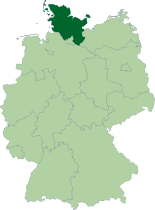Schleswig-Holstein, Germany
| Schleswig-Holstein | |||
|---|---|---|---|
| State of Germany | |||
|
|||
 |
|||
| Coordinates: 54°28′12″N 9°30′50″E / 54.47000°N 9.51389°E | |||
| Country | Germany | ||
| Capital | Kiel | ||
| Government | |||
| • Body | Landtag of Schleswig-Holstein | ||
| • Minister-President | Daniel Günther (CDU) | ||
| • Governing parties | CDU / Greens / FDP | ||
| • Bundesrat votes | 4 (of 69) | ||
| Area | |||
| • Total | 15,763.18 km2 (6,086.20 sq mi) | ||
| Population (2015-12-31) | |||
| • Total | 2,858,714 | ||
| • Density | 180/km2 (470/sq mi) | ||
| Time zone | CET (UTC+1) | ||
| • Summer (DST) | CEST (UTC+2) | ||
| ISO 3166 code | DE-SH | ||
| Vehicle registration | formerly: S (1945–1947), SH (1947), BS (1948–1956) | ||
| GDP/ Nominal | €86 billion (2015) | ||
| GDP per capita | €30,000 (2015) | ||
| NUTS Region | DEF | ||
| Website | schleswig-holstein.de | ||
Schleswig-Holstein (German: [ˈʃleːsvɪç ˈhɔlʃtaɪ̯n]; Danish: Slesvig-Holsten) is the northernmost of the 16 states of Germany, comprising most of the historical duchy of Holstein and the southern part of the former Duchy of Schleswig. Its capital city is Kiel; other notable cities are Lübeck and Flensburg.
Also known in more dated English as Sleswick-Holsatia, the Danish name is Slesvig-Holsten, the Low German name is Sleswig-Holsteen, and the North Frisian name is Slaswik-Holstiinj. Historically, the name can also refer to a larger region, containing both present-day Schleswig-Holstein and the former South Jutland County (Northern Schleswig) in Denmark.
The term "Holstein" derives from Old Saxon Holseta Land, (Holz and Holt mean wood in modern Standardised German and in literary English, respectively). Originally, it referred to the central of the three Saxon tribes north of the River Elbe: Tedmarsgoi (Dithmarschen), Holstein and Sturmarii (Stormarn). The area of the tribe of the Holsts was between the Stör River and Hamburg, and after Christianization, their main church was in Schenefeld. Saxon Holstein became a part of the Holy Roman Empire after Charlemagne's Saxon campaigns in the late eighth century. Since 811, the northern frontier of Holstein (and thus the Empire) was marked by the River Eider.
...
Wikipedia


